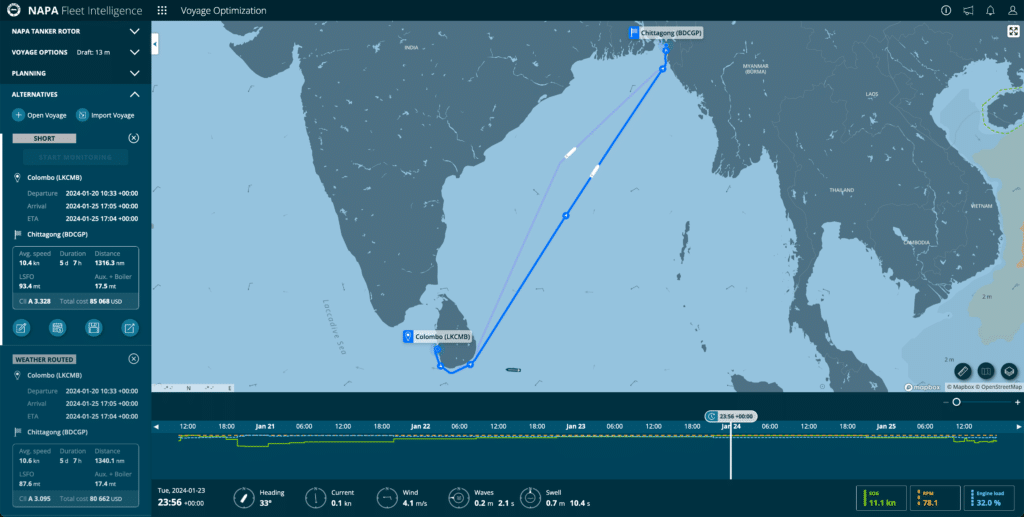
Op-Ed: Harnessing wind power for shipping requires data as much as sails
Written by
Ossi Mettälä
By Ossi Mettälä, product manager for shipping solutions, NAPA
Sails, wings, kites and rotors are only the most visible part of the advanced technology needed to truly embrace wind power in shipping. Those systems must work hand-in-hand with data—not only to adapt routes to catch optimal winds, but also to ensure safety and even help naval architects optimize their designs for wind-assisted vessels.
To state the obvious, ships equipped with wind power systems need … wind. And not just any wind; each technology has its own criteria and limits for the range of wind speeds and angles in which it can be operated safely and optimally.
This greater emphasis on wind conditions marks a step change in how ships are operated. It will inevitably lead to a greater reliance on weather routing and voyage optimization systems that use algorithms to automatically simulate different potential routes and speed profiles for a given sea journey, and model the impact of each option on the ship’s fuel consumption and greenhouse gas emissions. This enables crews to adjust the ship’s course and speed to make the most of wind patterns and maximize fuel and emissions savings.
Such a shift is essential because the complexity of routing wind-assisted vessels is much higher than for ships propelled solely by conventional engines. Fast-evolving wind speeds and direction, as well as waves and currents, must be assessed (and constantly re-assessed) throughout the voyage to determine the best possible route. Relying on traditional means will leave a lot of potential savings on the table—whereas algorithms can model the best possible options where manual methods fall short.
Turning the wind around
Recent modelling studies have provided concrete evidence of what was already evident: weather routing will be indispensable to tap into the full emissions-saving potential of wind propulsion. A joint simulation project between NAPA, Norsepower and Sumitomo Heavy Industries has found that combining wind power with voyage optimization can deliver emissions reductions of up to 28% on average on transatlantic journeys between New York and Amsterdam—with the contribution of voyage optimization estimated at 12%.

This is in line with a 2023 study by the University of Manchester, which concluded that voyage optimization amplifies carbon savings delivered by wind propulsion systems to over 30% on “ideal” routes where wind speed and angle are particularly favorable.
Crucially, the same study revealed that voyage optimization can turn routes from unfavorable to suitable for wind propulsion technology. This is because weather routing allows ships to adjust their course to alter detrimental wind angles, a finding that was also validated by recent NAPA simulations.
In tangible terms, when a ship faces constant headwinds, voyage optimization enables it to deviate from the shortest route to instead catch winds within the range of angles that are suitable for their sails, rotor or wings. Furthermore, the system enables them to vary their speed profile—in other words, adopt a wider range of speeds—to catch favorable winds and avoid unfavorable ones.
Safety and design decisions in wind power
The role of digital technology as a catalyst for wind propulsion isn’t limited to maximizing fuel and emissions savings; it also acts as a key tool to ensure safety at sea and to support decisions at the design stage.
With a growing number of technologies reaching maturity, decisions around the use of wind propulsion must be based on a holistic approach, to proactively assess how those systems will transform a wide range of aspects, from vessel designs to operational parameters and safety on board.
Wind propulsion systems typically add weight to the upper part of the ship, which impacts its center of gravity and stability profile more generally. The heel induced by the sails, as well as the added wave resistance and the impact of sea currents, must also be taken into consideration in voyage planning. Advanced stability software plays a key role in making vital calculations smoothly and accurately to ensure the safety of those vessels at sea.
Meanwhile, 3D models and simulation tools also help naval engineers and architects account for those parameters at the design stage. This enables them to model the impact of wind propulsion on the ship’s structure, stability, and configuration, providing key insights that helps them optimize concepts, both for newbuilds and retrofitting projects.
The same modelling capabilities can be used to help shipowners assess the business case for installing wind propulsion systems on their fleet, predict the potential emissions reductions on the specific routes where their ships are operated, and measure implications for any potential loss of cargo space, for example.
These objective assessments will be key to ground decisions in data and evidence, which will be critical to help wind propulsion technology truly take off.




